Great Yarmouth Corporation Tramways
History
Great Yarmouth Corporation applied for powers to construct an electric tramway system in 1898, the resultant act — the Great Yarmouth Corporation Act, 1899 — receiving its royal assent on the 1st August 1899.
At this point, the British Electric Traction Company appeared on the scene, a concern which was, during the late 1890s and early 1900s, embarking on a journey that would see it become a major player in the tramway world. It began by purchasing horse and steam-operated tramways across the British Isles with the intention of converting them to electric traction, as well as promoting schemes for completely new electric tramways, and was destined to own, part-own or lease over 50 tramway concerns across the United Kingdom. The BETCo clearly had its eye on building and/or operating an electric tramway system in Great Yarmouth, and in 1900, with this goal in mind, it gained a controlling interest in the local horse tramway — owned by the Yarmouth and Gorleston Tramway Company — which ran from Yarmouth South Town Station, via Feathers Plain, to the King William IV public house on the River Yare quayside. A subsidiary company was then set up — the Great Yarmouth and District Tramways Company — to acquire the necessary powers to convert the tramway to electric traction, and to construct and operate it.
The BETCo presumably hoped to persuade the corporation to support its scheme, or failing that, to obtain an operating lease for the as-yet-unbuilt municipal electric tramway. Although the corporation blocked all attempts by the BETCo to acquire its own powers, there was considerable opposition within the council to the concept of a municipally operated tramway, a campaign that ultimately failed by just a single vote.
Construction of the corporation's 3ft 6ins-gauge overhead electric system started on the 16th October 1901, the new electric services commencing eight months later on the 20th June 1902. The rest of the system followed in October 1904 and August 1905.
Meanwhile, the BETCo had been left to operate the horse tramway until such time as the corporation should decide to take it over. Under the Tramways Act of 1870, as well as the Yarmouth and Gorleston Tramways Extension Order of 1897, the corporation was entitled to compulsorily purchase the horse tramway within six months after the 23rd August 1904. The corporation duly obtained powers to take over the tramway and convert it to overhead electric traction; these were granted on the 15th August 1904 under the Great Yarmouth Corporation Act, 1904. Following this, an agreement on the value of the horse tramway was reached with the BETCo, the corporation taking ownership on the 12th March 1905, after which conversion to electric traction commenced. It is likely that the BETCo continued to operate the horse trams under a contract arrangement for a further four months, the last horse service running on the 4th July 1905, the same day that electric services commenced.
The tramway system reached its final size on the 16th May 1907 with the opening of the extension to Caister. By this time, the tram fleet numbered 35 vehicles.
The core of the municipal system lay along the spit of land between the River Yare and the sea, whilst the rebuilt horse tramway line lay to the west of the River Yare, the two parts of the system remaining physically unconnected for the entire lifetime of the tramway. At its maximum, the system extended to 9.94 miles, lines to the east of the Yare running from the junction of King Street and Regent Street: northwards through the Market Place, along Northgate Street, Caister Road and Yarmouth Road to Caister; eastwards along Regent Road then southwards along Marine Parade to Wellington Pier; southwards along King Street, Blackfriars Road, Camden Road and Admiralty Road, with a short branch along Barrack Road to the Fish Wharf; westwards along Regent Street, turning northwards along North Quay to join the Caister line via Fullers Hill, with a short branch to Vauxhall Station; and lastly, a short connecting line between King Street and Marine Parade along St Peters Road. To the west of the Yare, the line ran westwards from Haven Bridge to South Town Station, where it turned southwards along Southtown Road and High Street to Feathers Plain in Gorleston, and on to a terminus along Lowestoft Road near Gorleston-on-Sea railway station; a branch also ran eastwards from Feathers Plain along Baker Street, Pier Plain and Pier Walk to Gorleston Quay and the beach.
Like most tramways on the British mainland, Great Yarmouth's suffered during the Great War from a loss of staff (and their skills), as well as an inability to carry out anything other than minimal maintenance, with acquisition of new track or spares proving extremely challenging if not impossible. As a result, the system emerged from the conflict in badly run-down condition, the first call on funds after the conflict being to make good the backlog of track and vehicle repairs.
By 1920, the corporation was giving some thought to the future of transport within the town, and authorised the purchase of a number of second-hand motorbuses, which were used experimentally for one month (from the 6th October 1920), then as a supplementary service on the Caister tramway route. Bus operation was evidently considered a success, as when the King Street to Fish Wharf section of the tramway required track renewal, it was abandoned, on the 14th May 1924 — in favour of motorbus services — along with the St Peters Road and Vauxhall Station to Fullers Hill lines, both of which had always run at a loss.
Although much of the track on the remainder of the system was also in poor condition, the corporation still viewed the tramway as the core of its municipal transport service, so it borrowed heavily to renew the track and rebuild the tramcar fleet between 1924 and 1926. New bus services continued to be introduced in the late 1920s, and as the economic case for them became ever more compelling, a decision was made to abandon the short line to Vauxhall Station, the last tramcar service over it running on the 6th October 1929. This left just two lines operating — Southtown to Gorleston, and Wellington Pier to Caister — it only being a matter of time before any call for significant expenditure would see them close too. The Gorleston line succumbed on the 25th September 1930, three years before the last tram of all ran, with much ceremony, on the 14th December 1933.
Uniforms
There is some evidence to suggest that motormen and conductors, of whom there were initially 24 of each, initially wore double-breasted, naval-style jackets of indigo blue, along with soft-topped caps, though confirmatory photographic evidence is currently lacking. These early uniforms cost £1-18s-6d each.
In 1905, the above uniforms were replaced by single-breasted jackets with lapels and four buttons (bearing the full system title and municipal shield — see link); the lapels, along with the jacket edges and cuffs, were all piped in silver braid (as were the trousers). Other than the buttons, the jackets appear to have been plain, i.e., devoid of badges. The peaked caps were nautical in style with a soft top and glossy peak, and bore a large cap badge comprising the Great Yarmouth municipal 'scalloped' shield, within a garter containing the system title: 'GREAT YARMOUTH CORPORATION TRAMWAYS'. Examples of badges and buttons have survived in both gilded brass and in nickel, suggesting that a transition was made at some stage from one to the other, most probably from the former to the latter.
At some point, probably in the late-Edwardian era, the uniforms were changed once again to a double-breasted lancer-style of tunic with five pairs of buttons (narrowing from top to bottom), and stand-up collars. The latter carried an employee number on the bearer's left-hand side (in individual metal numerals) and systems initials — 'G Y C T' — on the right-hand side (in individual metal letters). Although initially without epaulettes, these were later added, and were used for the employee number, with the collars then carrying a small municipal-device badge (on each side). The precise chronology of this change is unclear, with a staff photo taken in the mid 1920s clearly showing a mix of both types. The caps were probably changed at the same time as the tunics, to a tensioned-crown (top) type; these continued to carry the same cap badge as previously, and were embellished with braided cord (at least initially).
Tramway crews were also issued with double-breasted greatcoats with five pairs of buttons and high fold-over collars; the latter bore system initials on both sides — 'G Y C T' — in individual metal letters. In later years, the greatcoats bore epaulettes, and these, along with the collars, were worn without insignia, even the buttons being plain.
Motormen and conductors were required to wear a round enamel licence badge when working. This was usually hung from a button on the bearer's left breast; it bore a number, the full system title and the grade, all in black lettering on a white background.
Inspectors, initially numbering three individuals, were issued with single-breasted jackets with hidden buttons (or more likely a hook and eye affair), and a slit breast pocket, all edged in a finer material than the main body, and with stand-up collars; the latter probably bore the grade — 'Inspector' — in embroidered script-lettering. The drooping-peak caps bore a large, oval-shaped cap badge of unknown pattern. The first uniforms cost £2-0s-6d. The drooping-peak caps were subsequently replaced by tensioned-crown, peaked caps, which continued to carry the same badge as the earlier caps. The uniform jacket was eventually changed to a more modern design, certainly by the 1920s, and whilst still single-breasted with hook and eye fastenings, now bore epaulettes and two breast pockets (with button closures).
Great Yarmouth also employed the services of a Chief Inspector, who can be glimpsed at the controls of a decorated tramcar in the Caister opening photograph below. His jacket, which was modelled on a British military patrol jacket, was single-breasted with hook and eye fastening and stand-up collars; it also bore elaborate decorative braided loops. It is unclear whether the collars bore any insignia. The cap was very similar to those worn by inspectors, carrying a very similar if not identical cap badge, but with decorative braid on the peak. It seems highly likely this style of uniform was superseded by a more modern design at some point, though no details are available.
In common with the vast majority of UK tramway systems, Great Yarmouth employed female staff during the Great War (starting in 1916) to replace male staff lost to the armed services. Unfortunately, photographs are yet to come to light, so all that is known comes from paper records, which indicate that 10 long-skirted uniforms were initially purchased at a cost of at 35 shillings each. However, given as only 5 straw hats (with bands) were purchased in the summer of 1917, at a cost of 4 shillings each, it would appear that only that number of ladies had actually been appointed, though 10 winter overcoats were purchased at the same time, presumably in anticipation of further recruitment. Five more sets of uniforms (including gaiters) were purchased in 1918. In June 1919, instructions were issued for the sale of female uniforms, suggesting that all the ladies had departed by this time.
I am indebted to David Mackley (and the late Terry Barker) for much of the information above, and to Colin Tooke (as well as David) for permission to reproduce many of the photographs shown below.
Further reading
For a photographic history of Yarmouth's tramways, see 'Great Yarmouth Tramways' by David Mackley; Middleton Press (2003).
Images
Motormen and conductors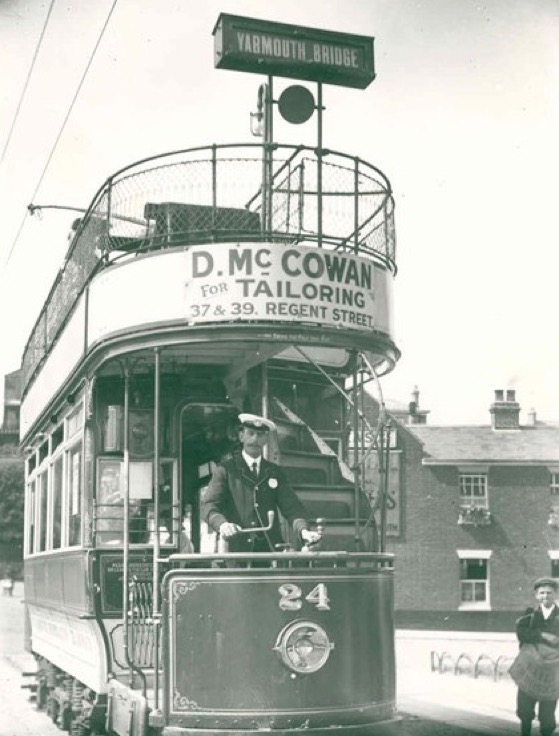
A brand-new Tramcar No 24 posed for the cameraman on the Gorleston-South Town route with a service bound for Yarmouth Bridge — photo undated, but probably taken around the time the route was opened, i.e., July 1905. The motorman is wearing a single-breasted jacket with lapels, and a soft-topped cap bearing a large round cap badge (see below). His left breast bears a black and white enamel licence badge.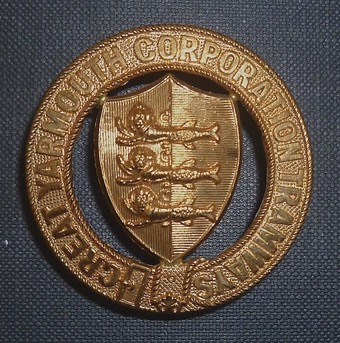
Great Yarmouth Corporation Tramways cap badge — gilded brass. Author's Collection.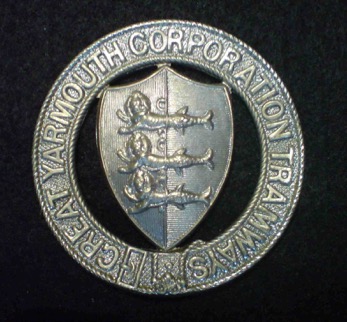
Great Yarmouth Corporation Tramways cap badge — nickel. Author's Collection.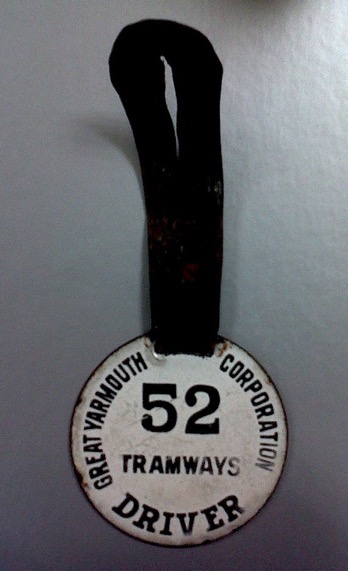
Great Yarmouth Corporation Tramways driver's licence badge — black and white enamel. With thanks to the National Tramway Museum.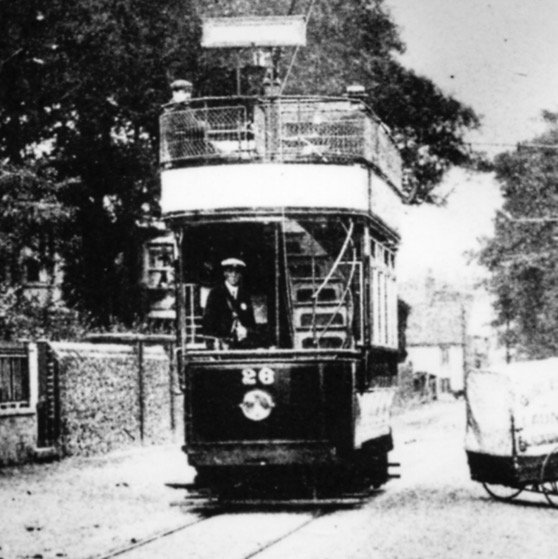
The conductor of Tramcar No 26 stares back at the camera as his vehicle traverses Pier Plain in 1905/6. The conductor is wearing a soft-topped cap with a white summer rain cover. Photo courtesy of the Tramways and Light Railway Society, with thanks to David Voice.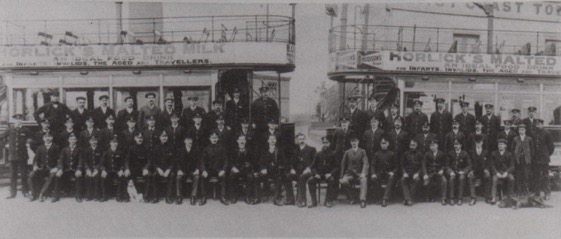
A composite photo taken in 1905 showing the tramway's staff, Caister depot on the left and Gorleston depot on the right. Photo courtesy of the David Mackley Collection.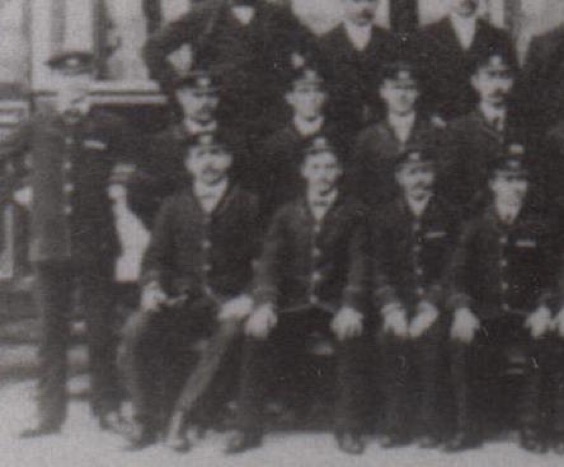
An enlargement of the above photograph showing some of the conductors and motormen, all in single-breasted jackets edged in silver piping, and with soft-topped peaked caps.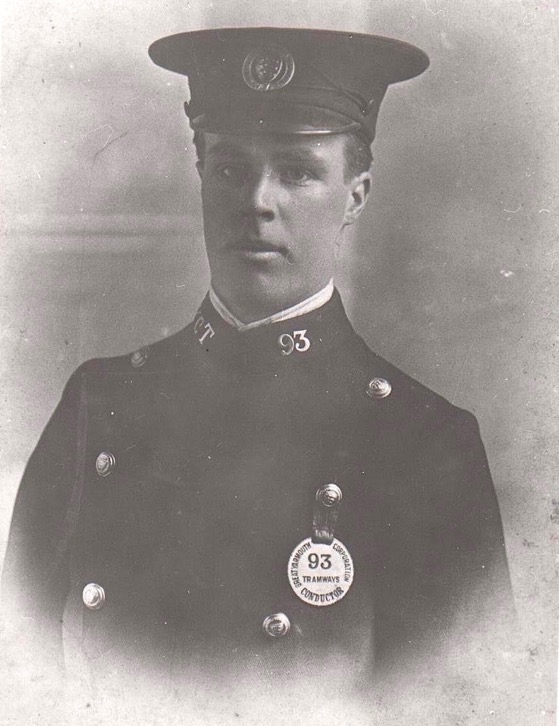
A studio portrait of an unknown Great Yarmouth Corporation Tramways conductor — photo undated, but probably late Edwardian. By this time, the soft-topped peaked caps had clearly been superseded by caps with a tensioned crown (top), which were embellished, somewhat unusually, with braided cord. His employee number (on his left-hand collar) and his licence badge number are identical (No 93), which was usually not the case with most other tramway systems, as the licensing authority (or department) and the tramway were invariably separate entities. Photo courtesy of the David Mackley Collection.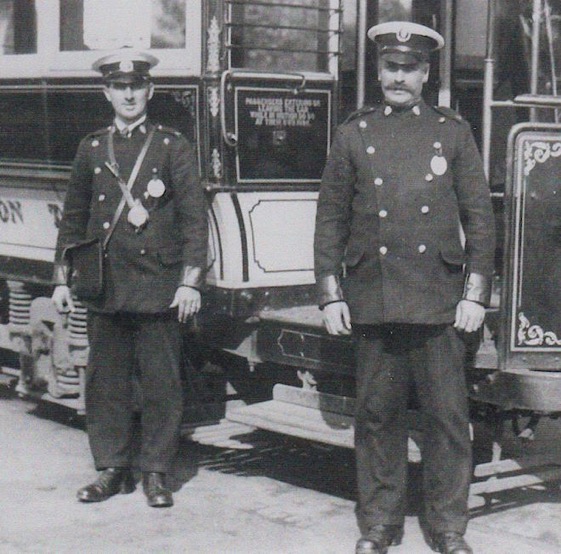
A conductor and a motorman with Tramcar No 32 — photo undated, but probably taken either shortly before or shortly after the Great War. The employee numbers had by this time migrated to the epaulettes, with both the collars now bearing a small municipal-device badge (see below). Photo courtesy of the Colin Tooke Collection.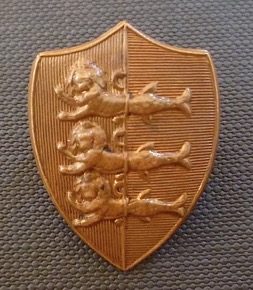
Great Yarmouth Corporation collar badge — brass. This badge began to be used on the stand-up collars of the uniform tunics from around the time of the Great War, and in later years, was sometimes substituted for the larger cap badge. Author's Collection.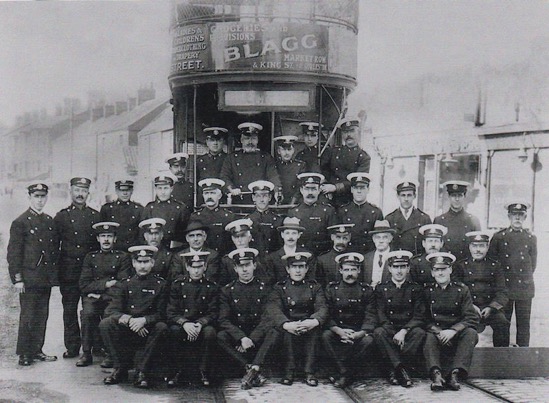
A group of tramcar crews assembled in the roadway outside the Feathers Plain depot (Gorleston) — photo undated, but certainly taken between 1922 and 1930 as the figure in the centre — Mr P G Campling — was the General Manager during this period. Photo courtesy of the Colin Tooke Collection.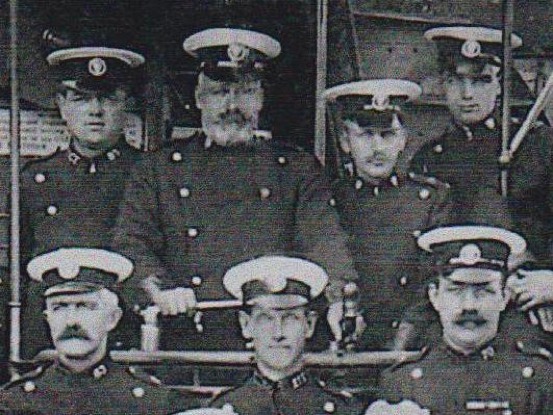
An enlargement of the above photograph showing some of the motormen and conductors. Some have the older 'G Y C T' initials and employee numbers, whilst others have the small municipal-device badge, and others still are plain.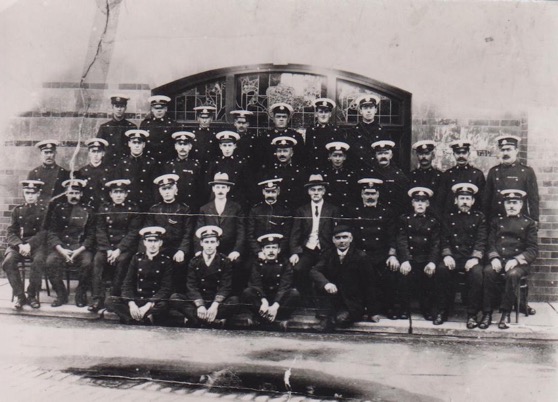
Another photograph of Gorleston staff, this time assembled in front of the library window, which was adjacent to the depot. It was probably taken at the same time as the preceding photograph, given that it appears to be the identical group of men. Photo courtesy of the David Mackley Collection.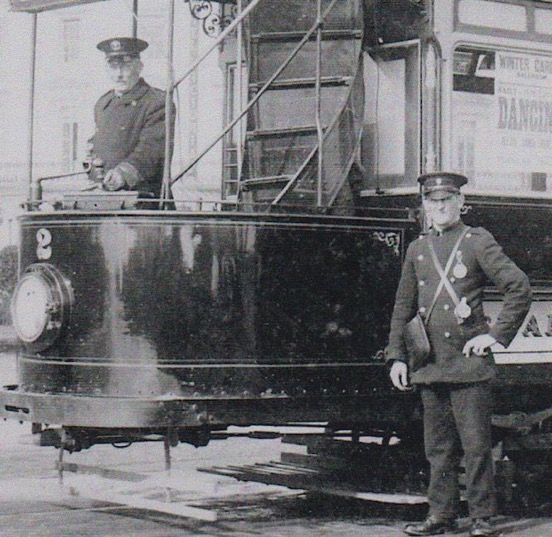
The crew of an immaculately turned-out Tramcar No 2 pose for the camera late in the system's life, probably in the late 1920s or even the early 1930s. The conductor has no insignia on either his collars or his epaulettes, and his cap badge is the small municipal-device badge previously worn on the tunic collars. Photo courtesy of the Colin Tooke Collection.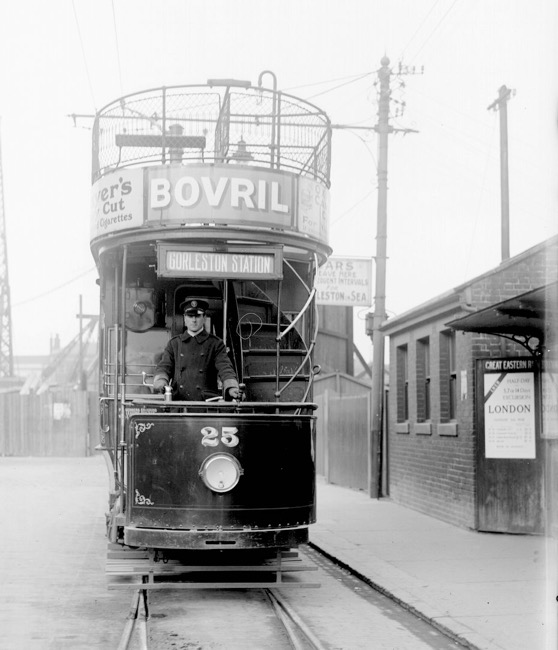
Tramcar No 25 stands in Bridge Road at the South Town terminus in 1929. Photo by Dr H Nicol, courtesy of the National Tramway Museum. 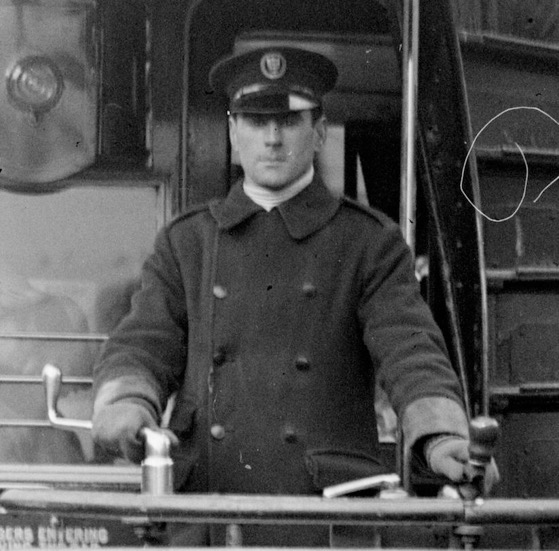
An enlargement of the above photograph showing the motorman. Other than his prominent cap badge, his entire greatcoat appears to be devoid of insignia, inclusive of the buttons, which are plain. 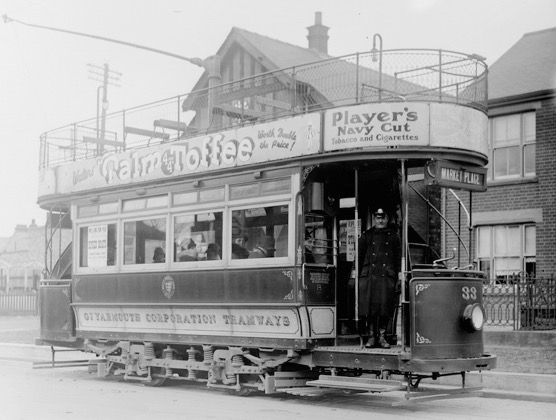
Tramcar No 33 stands at the Caister terminus with a service for the Market Place — photo undated, but probably taken in the late 1920s or early 1930s. Photo by Dr H Nicol, courtesy of the National Tramway Museum. 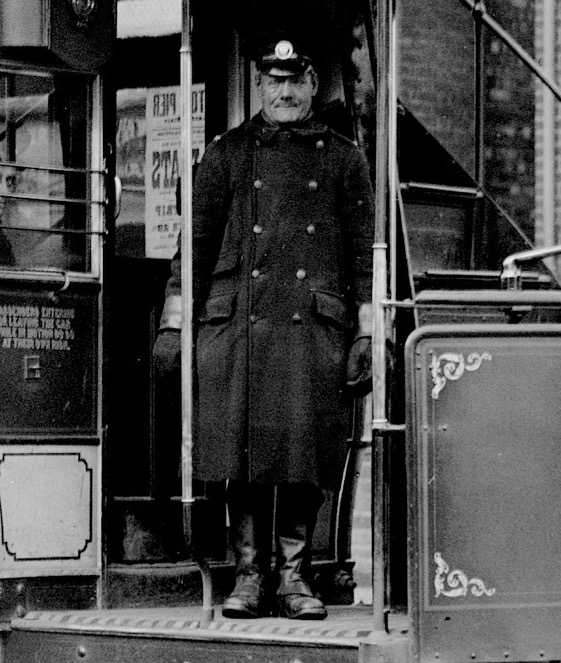
An enlargement of the above photograph showing the motorman in his greatcoat, which again appears to be devoid of insignia.
Senior staff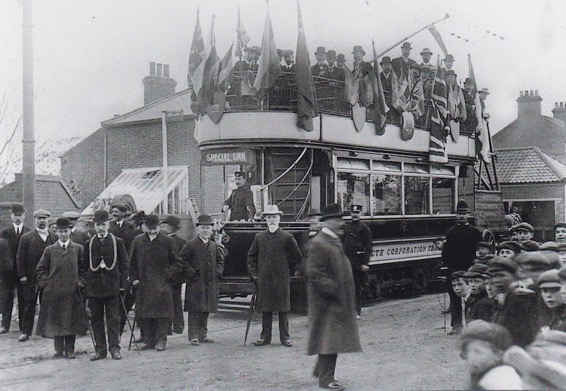
A heavily bedecked special car, used during the opening of the new Caister line on 16th May 1907. Both uniformed figures, including the driver, are senior staff, Photo courtesy of the Colin Tooke Collection.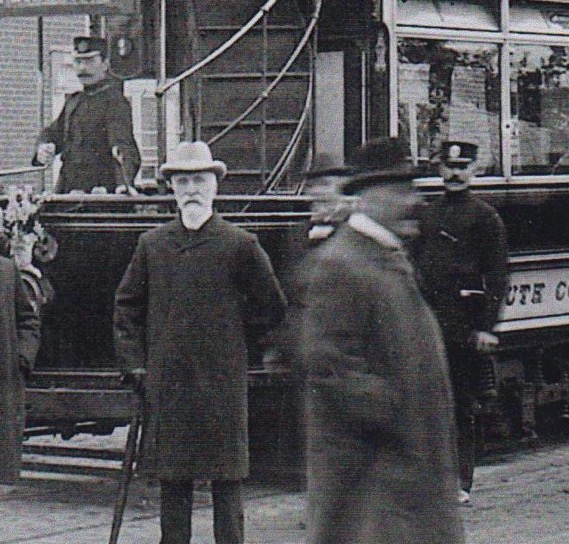
An enlargement of the above photograph showing the two senior staff. The man on the right is an inspector, and is wearing a typical uniform for the grade. Although difficult to make out, the man at the controls is the Chief Inspector; he is wearing an elaborate jacket modelled on a British military patrol jacket, with decorative braid loops. Both men are wearing drooping-peak caps bearing a markedly larger badge than the pattern issued to motormen and conductors.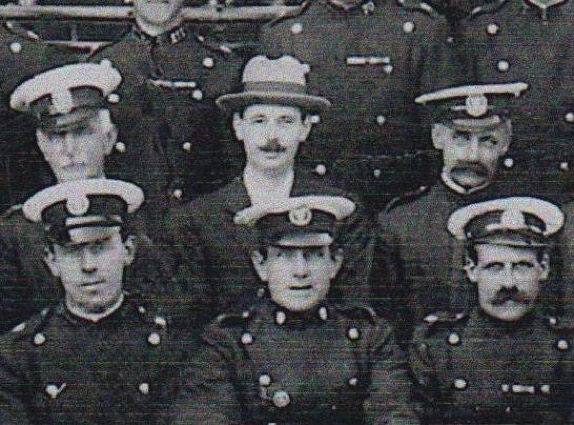
An enlargement of the 1920s Gorleston staff photograph shown above, which includes the General Manager (centre back), and either side of him, two inspectors. Their cap badges are once again noticeably larger than those worn by tramcar staff, and are oval (tall) rather than circular.